Abstract
Tumor necrosis factor (TNF) is a cytokine which mediates endotoxin shock and causes multiple organ damage. It is thought that macrophage (MP) activation is necessary to increase lipopolysaccharide (LPS)-induced TNF production and lethality. Carrageenan (CAR) is sulfated polygalactose which destroys MP; it is used as a MP blocker. We found that CAR pretreatment can increase both endotoxin-induced TNF production and the mortality rate in mice. The ddY mice (7 to 8 weeks old) were injected intraperitoneally with CAR (5-mg dose) and challenged intravenously with LPS 24 h later. Without CAR pretreatment, LPS doses of less than 10 micrograms did not induce TNF in sera. After pretreatment, however, about 3 x 10(3) to 4 x 10(4) U of TNF per ml was produced after LPS injection at doses of 0.1 to 10 micrograms, respectively. TNF production was significantly increased by CAR pretreatment at LPS doses of more than 10 micrograms. CAR pretreatment rendered the mice more sensitive to the lethal effect of LPS; 50% lethal doses of LPS in CAR-pretreated mice and nonpretreated mice were 26.9 and 227 micrograms, respectively. The mortality of the two groups was significantly different at doses of 50, 100, and 200 micrograms of LPS. CAR increased LPS-induced TNF production and mortality within 2 h, much earlier than MP activators, which needed at least 4 days. Our results made clear that TNF production is enhanced not only by a MP activator but also by a MP blocker.
Full text
PDF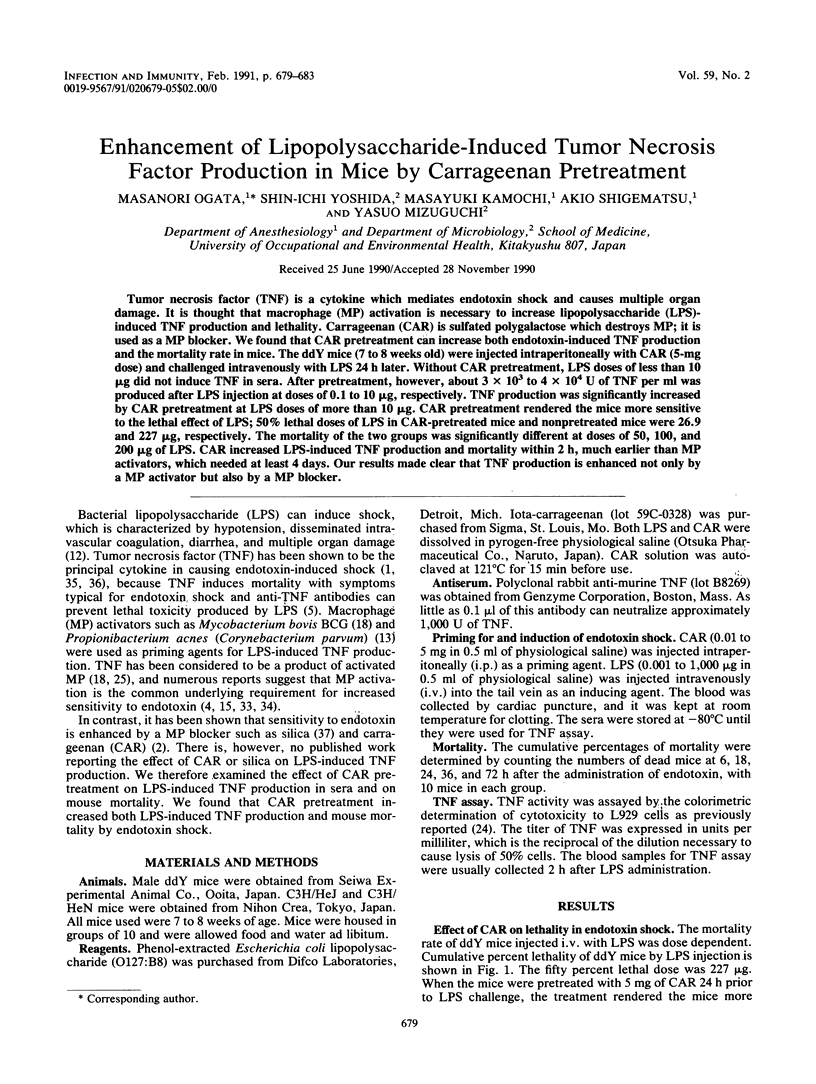
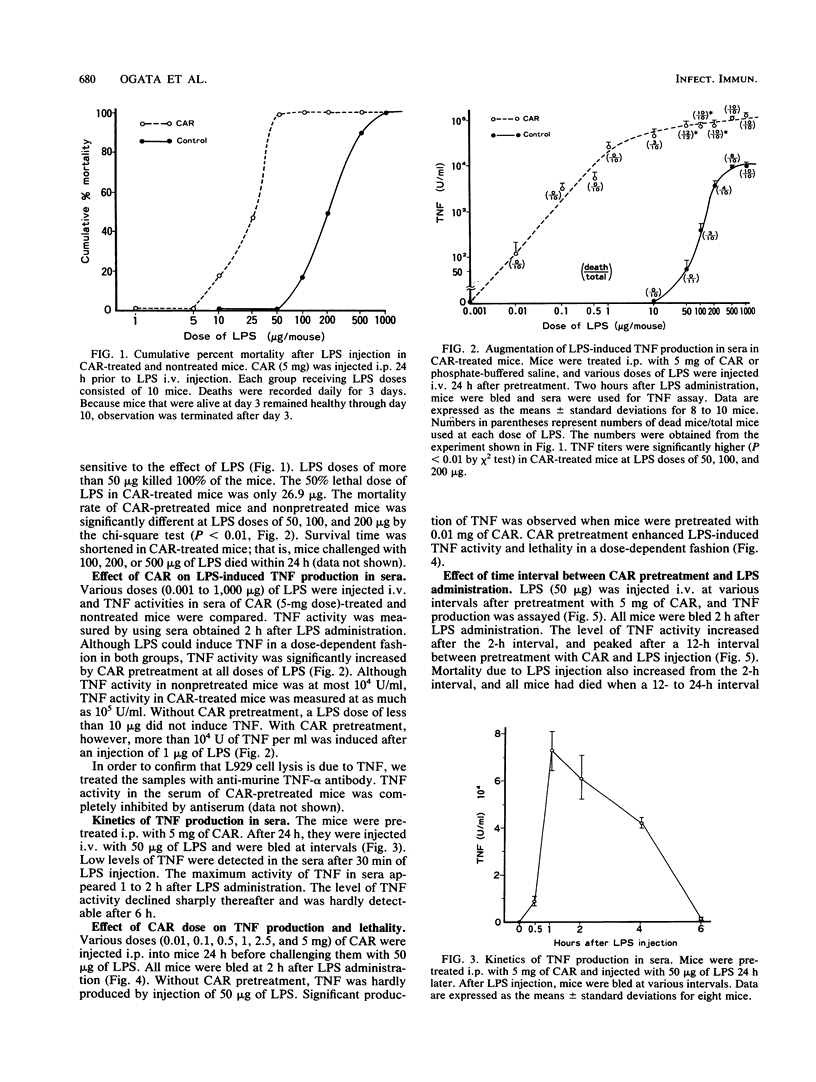
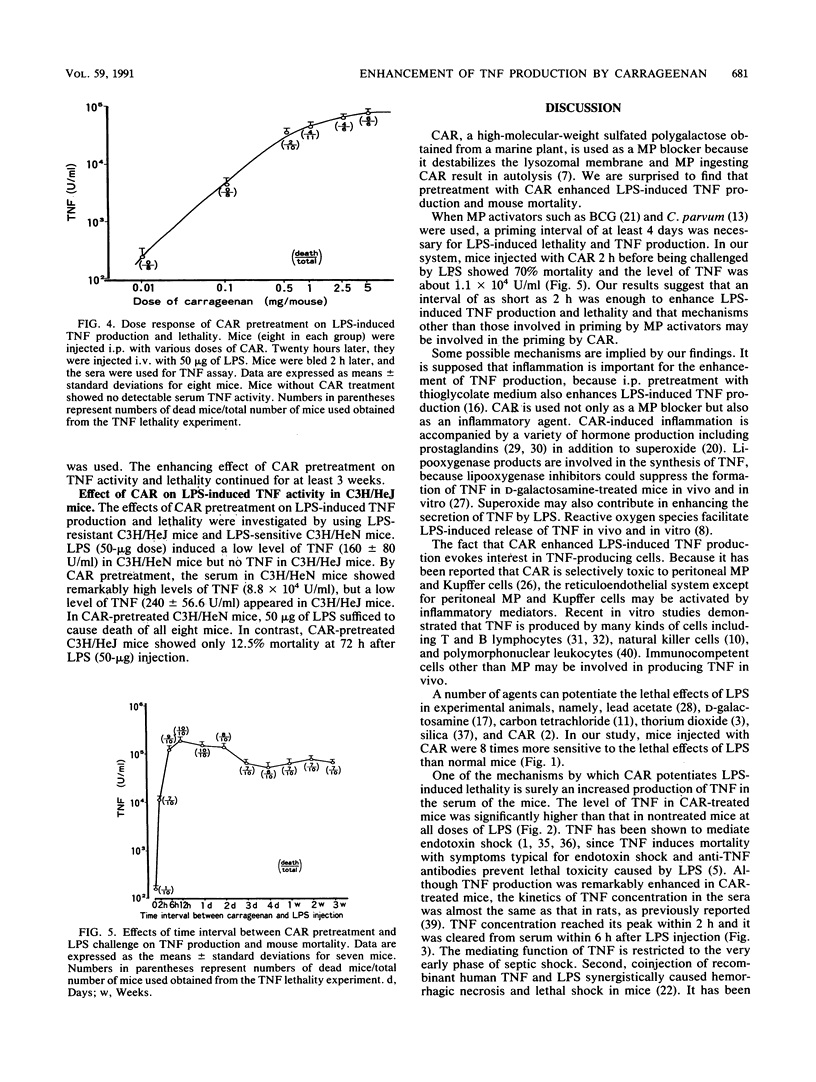
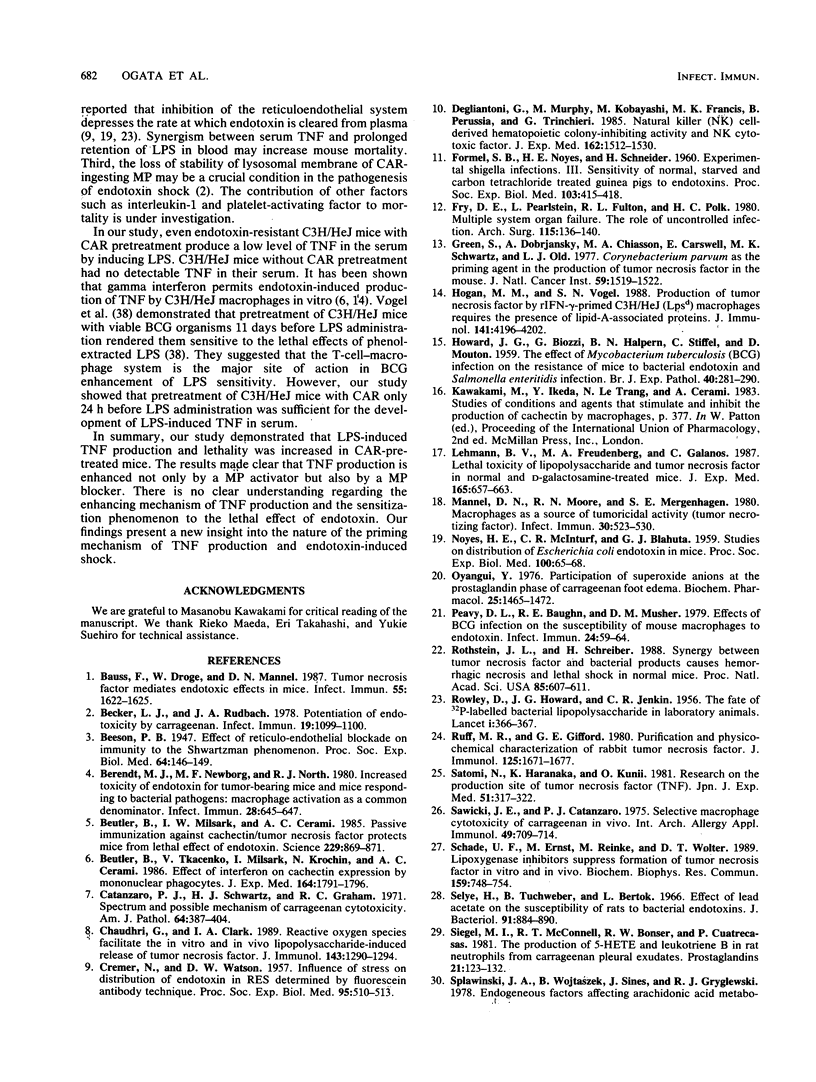
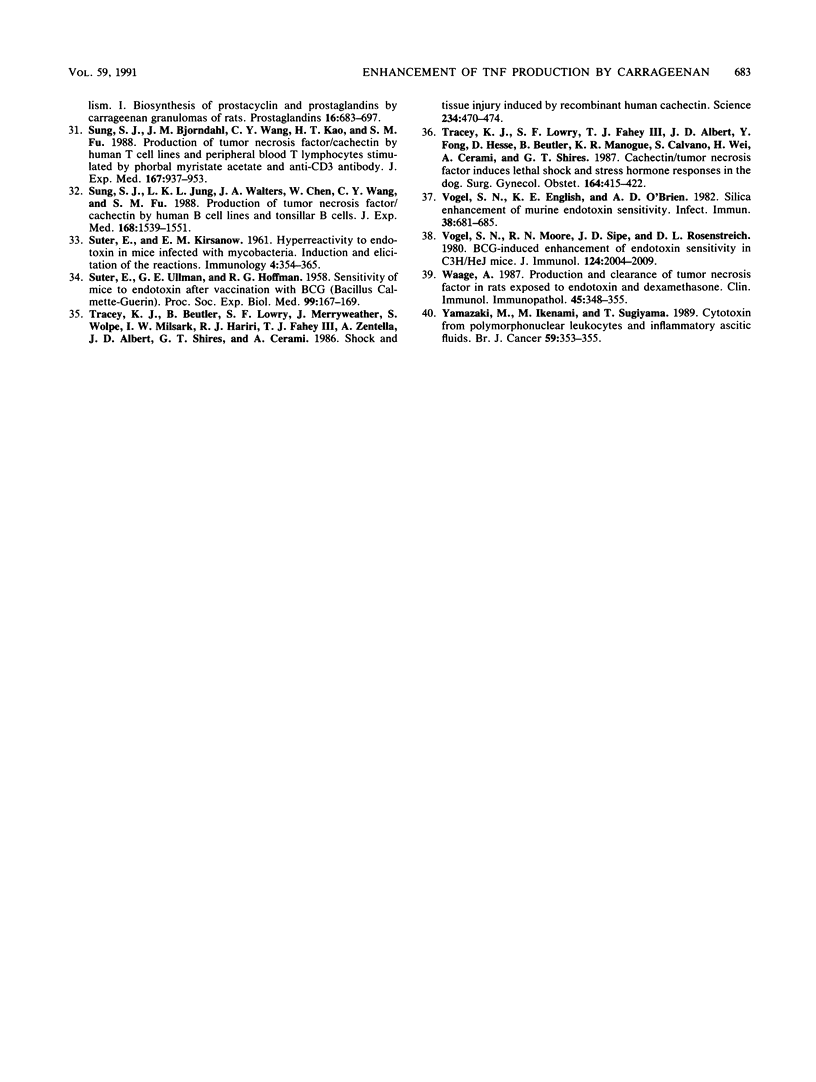
Selected References
These references are in PubMed. This may not be the complete list of references from this article.
- Bauss F., Dröge W., Männel D. N. Tumor necrosis factor mediates endotoxic effects in mice. Infect Immun. 1987 Jul;55(7):1622–1625. doi: 10.1128/iai.55.7.1622-1625.1987. [DOI] [PMC free article] [PubMed] [Google Scholar]
- Becker L. J., Rudbach J. A. Potentiation of endotoxicity by carrageenan. Infect Immun. 1978 Mar;19(3):1099–1100. doi: 10.1128/iai.19.3.1099-1100.1978. [DOI] [PMC free article] [PubMed] [Google Scholar]
- Berendt M. J., Newborg M. F., North R. J. Increased toxicity of endotoxin for tumor-bearing mice and mice responding to bacterial pathogens: macrophage activation as a common denominator. Infect Immun. 1980 May;28(2):645–647. doi: 10.1128/iai.28.2.645-647.1980. [DOI] [PMC free article] [PubMed] [Google Scholar]
- Beutler B., Milsark I. W., Cerami A. C. Passive immunization against cachectin/tumor necrosis factor protects mice from lethal effect of endotoxin. Science. 1985 Aug 30;229(4716):869–871. doi: 10.1126/science.3895437. [DOI] [PubMed] [Google Scholar]
- Beutler B., Tkacenko V., Milsark I., Krochin N., Cerami A. Effect of gamma interferon on cachectin expression by mononuclear phagocytes. Reversal of the lpsd (endotoxin resistance) phenotype. J Exp Med. 1986 Nov 1;164(5):1791–1796. doi: 10.1084/jem.164.5.1791. [DOI] [PMC free article] [PubMed] [Google Scholar]
- CREMER N., WATSON D. W. Influence of stress on distribution of endotoxin in RES determined by fluorescein antibody technic. Proc Soc Exp Biol Med. 1957 Jul;95(3):510–513. doi: 10.3181/00379727-95-23271. [DOI] [PubMed] [Google Scholar]
- Catanzaro P. J., Schwartz H. J., Graham R. C., Jr Spectrum and possible mechanism of carrageenan cytotoxicity. Am J Pathol. 1971 Aug;64(2):387–404. [PMC free article] [PubMed] [Google Scholar]
- Chaudhri G., Clark I. A. Reactive oxygen species facilitate the in vitro and in vivo lipopolysaccharide-induced release of tumor necrosis factor. J Immunol. 1989 Aug 15;143(4):1290–1294. [PubMed] [Google Scholar]
- Degliantoni G., Murphy M., Kobayashi M., Francis M. K., Perussia B., Trinchieri G. Natural killer (NK) cell-derived hematopoietic colony-inhibiting activity and NK cytotoxic factor. Relationship with tumor necrosis factor and synergism with immune interferon. J Exp Med. 1985 Nov 1;162(5):1512–1530. doi: 10.1084/jem.162.5.1512. [DOI] [PMC free article] [PubMed] [Google Scholar]
- FORMAL S. B., NOYES H. E., SCHNEIDER H. Experimental Shigella infections. III. Sensitivity of normal, starved and carbon tetrachloride treated guinea pigs to endotoxin. Proc Soc Exp Biol Med. 1960 Feb;103:415–418. doi: 10.3181/00379727-103-25541. [DOI] [PubMed] [Google Scholar]
- Fry D. E., Pearlstein L., Fulton R. L., Polk H. C., Jr Multiple system organ failure. The role of uncontrolled infection. Arch Surg. 1980 Feb;115(2):136–140. doi: 10.1001/archsurg.1980.01380020006003. [DOI] [PubMed] [Google Scholar]
- Green S., Dobrjansky A., Chiasson M. A., Carswell E., Schwartz M. K., Old L. J. Corynebacterium parvum as the priming agent in the production of tumor necrosis factor in the mouse. J Natl Cancer Inst. 1977 Nov;59(5):1519–1522. doi: 10.1093/jnci/59.5.1519. [DOI] [PubMed] [Google Scholar]
- HOWARD J. G., BIOZZI G., HALPERN B. N., STIFFEL C., MOUTON D. The effect of Mycobacterium tuberculosis (BCG) infection on the resistance of mice to bacterial endotoxin and Salmonella enteritidis infection. Br J Exp Pathol. 1959 Jun;40(3):281–290. [PMC free article] [PubMed] [Google Scholar]
- Hogan M. M., Vogel S. N. Production of tumor necrosis factor by rIFN-gamma-primed C3H/HeJ (Lpsd) macrophages requires the presence of lipid A-associated proteins. J Immunol. 1988 Dec 15;141(12):4196–4202. [PubMed] [Google Scholar]
- Lehmann V., Freudenberg M. A., Galanos C. Lethal toxicity of lipopolysaccharide and tumor necrosis factor in normal and D-galactosamine-treated mice. J Exp Med. 1987 Mar 1;165(3):657–663. doi: 10.1084/jem.165.3.657. [DOI] [PMC free article] [PubMed] [Google Scholar]
- Männel D. N., Moore R. N., Mergenhagen S. E. Macrophages as a source of tumoricidal activity (tumor-necrotizing factor). Infect Immun. 1980 Nov;30(2):523–530. doi: 10.1128/iai.30.2.523-530.1980. [DOI] [PMC free article] [PubMed] [Google Scholar]
- NOYES H. E., McINTURF C. R., BLAHUTA G. J. Studies on distribution of Escherichia coli endotoxin in mice. Proc Soc Exp Biol Med. 1959 Jan;100(1):65–68. doi: 10.3181/00379727-100-24525. [DOI] [PubMed] [Google Scholar]
- Oyanagui Y. Participation of superoxide anions at the prostaglandin phase of carrageenan foot-oedema. Biochem Pharmacol. 1976 Jul 1;25(13):1465–1472. [PubMed] [Google Scholar]
- Peavy D. L., Baughn R. E., Musher D. M., Musher D. M. Effects of BCG infection on the susceptibility of mouse macrophages to endotoxin. Infect Immun. 1979 Apr;24(1):59–64. doi: 10.1128/iai.24.1.59-64.1979. [DOI] [PMC free article] [PubMed] [Google Scholar]
- ROWLEY D., HOWARD J. G., JENKIN C. R. The fate of 32P-labelled bacterial lipopolysaccharide in laboratory animals. Lancet. 1956 Apr 7;270(6919):366–367. doi: 10.1016/s0140-6736(56)90110-6. [DOI] [PubMed] [Google Scholar]
- Rothstein J. L., Schreiber H. Synergy between tumor necrosis factor and bacterial products causes hemorrhagic necrosis and lethal shock in normal mice. Proc Natl Acad Sci U S A. 1988 Jan;85(2):607–611. doi: 10.1073/pnas.85.2.607. [DOI] [PMC free article] [PubMed] [Google Scholar]
- Ruff M. R., Gifford G. E. Purification and physico-chemical characterization of rabbit tumor necrosis factor. J Immunol. 1980 Oct;125(4):1671–1677. [PubMed] [Google Scholar]
- SUTER E., KIRSANOW E. M. Hyperreactivity to endotoxin in mice infected with mycobacteria. Induction and elicitation of the reactions. Immunology. 1961 Oct;4:354–365. [PMC free article] [PubMed] [Google Scholar]
- SUTER E., ULLMAN G. E., HOFFMAN R. G. Sensitivity of mice to endotoxin after vaccination with BCG (Bacillus Calmette-Guérin). Proc Soc Exp Biol Med. 1958 Oct;99(1):167–169. doi: 10.3181/00379727-99-24282. [DOI] [PubMed] [Google Scholar]
- Satomi N., Haranaka K., Kunii O. Research on the production site of tumor necrosis factor (TNF). Jpn J Exp Med. 1981 Dec;51(6):317–322. [PubMed] [Google Scholar]
- Sawicki J. E., Catanzaro P. J. Selective macrophage cytotoxicity of carrageenan in vivo. Int Arch Allergy Appl Immunol. 1975;49(5):709–714. doi: 10.1159/000231451. [DOI] [PubMed] [Google Scholar]
- Schade U. F., Ernst M., Reinke M., Wolter D. T. Lipoxygenase inhibitors suppress formation of tumor necrosis factor in vitro and in vivo. Biochem Biophys Res Commun. 1989 Mar 15;159(2):748–754. doi: 10.1016/0006-291x(89)90058-2. [DOI] [PubMed] [Google Scholar]
- Selye H., Tuchweber B., Bertók L. Effect of lead acetate on the susceptibility of rats to bacterial endotoxins. J Bacteriol. 1966 Feb;91(2):884–890. doi: 10.1128/jb.91.2.884-890.1966. [DOI] [PMC free article] [PubMed] [Google Scholar]
- Siegel M. I., McConnell R. T., Bonser R. W., Cuatrecasas P. The production of 5-HETE and leukotriene B in rat neutrophils from carrageenan pleural exudates. Prostaglandins. 1981 Jan;21(1):123–132. doi: 10.1016/0090-6980(81)90202-1. [DOI] [PubMed] [Google Scholar]
- Sung S. S., Bjorndahl J. M., Wang C. Y., Kao H. T., Fu S. M. Production of tumor necrosis factor/cachectin by human T cell lines and peripheral blood T lymphocytes stimulated by phorbol myristate acetate and anti-CD3 antibody. J Exp Med. 1988 Mar 1;167(3):937–953. doi: 10.1084/jem.167.3.937. [DOI] [PMC free article] [PubMed] [Google Scholar]
- Sung S. S., Jung L. K., Walters J. A., Chen W., Wang C. Y., Fu S. M. Production of tumor necrosis factor/cachectin by human B cell lines and tonsillar B cells. J Exp Med. 1988 Nov 1;168(5):1539–1551. doi: 10.1084/jem.168.5.1539. [DOI] [PMC free article] [PubMed] [Google Scholar]
- Tracey K. J., Beutler B., Lowry S. F., Merryweather J., Wolpe S., Milsark I. W., Hariri R. J., Fahey T. J., 3rd, Zentella A., Albert J. D. Shock and tissue injury induced by recombinant human cachectin. Science. 1986 Oct 24;234(4775):470–474. doi: 10.1126/science.3764421. [DOI] [PubMed] [Google Scholar]
- Tracey K. J., Lowry S. F., Fahey T. J., 3rd, Albert J. D., Fong Y., Hesse D., Beutler B., Manogue K. R., Calvano S., Wei H. Cachectin/tumor necrosis factor induces lethal shock and stress hormone responses in the dog. Surg Gynecol Obstet. 1987 May;164(5):415–422. [PubMed] [Google Scholar]
- Vogel S. N., English K. E., O'Brien A. D. Silica enhancement of murine endotoxin sensitivity. Infect Immun. 1982 Nov;38(2):681–685. doi: 10.1128/iai.38.2.681-685.1982. [DOI] [PMC free article] [PubMed] [Google Scholar]
- Vogel S. N., Moore R. N., Sipe J. D., Rosenstreich D. L. BCG-induced enhancement of endotoxin sensitivity in C3H/HeJ mice. I. In vivo studies. J Immunol. 1980 Apr;124(4):2004–2009. [PubMed] [Google Scholar]
- Waage A. Production and clearance of tumor necrosis factor in rats exposed to endotoxin and dexamethasone. Clin Immunol Immunopathol. 1987 Dec;45(3):348–355. doi: 10.1016/0090-1229(87)90087-0. [DOI] [PubMed] [Google Scholar]
- Yamazaki M., Ikenami M., Sugiyama T. Cytotoxin from polymorphonuclear leukocytes and inflammatory ascitic fluids. Br J Cancer. 1989 Mar;59(3):353–355. doi: 10.1038/bjc.1989.70. [DOI] [PMC free article] [PubMed] [Google Scholar]


